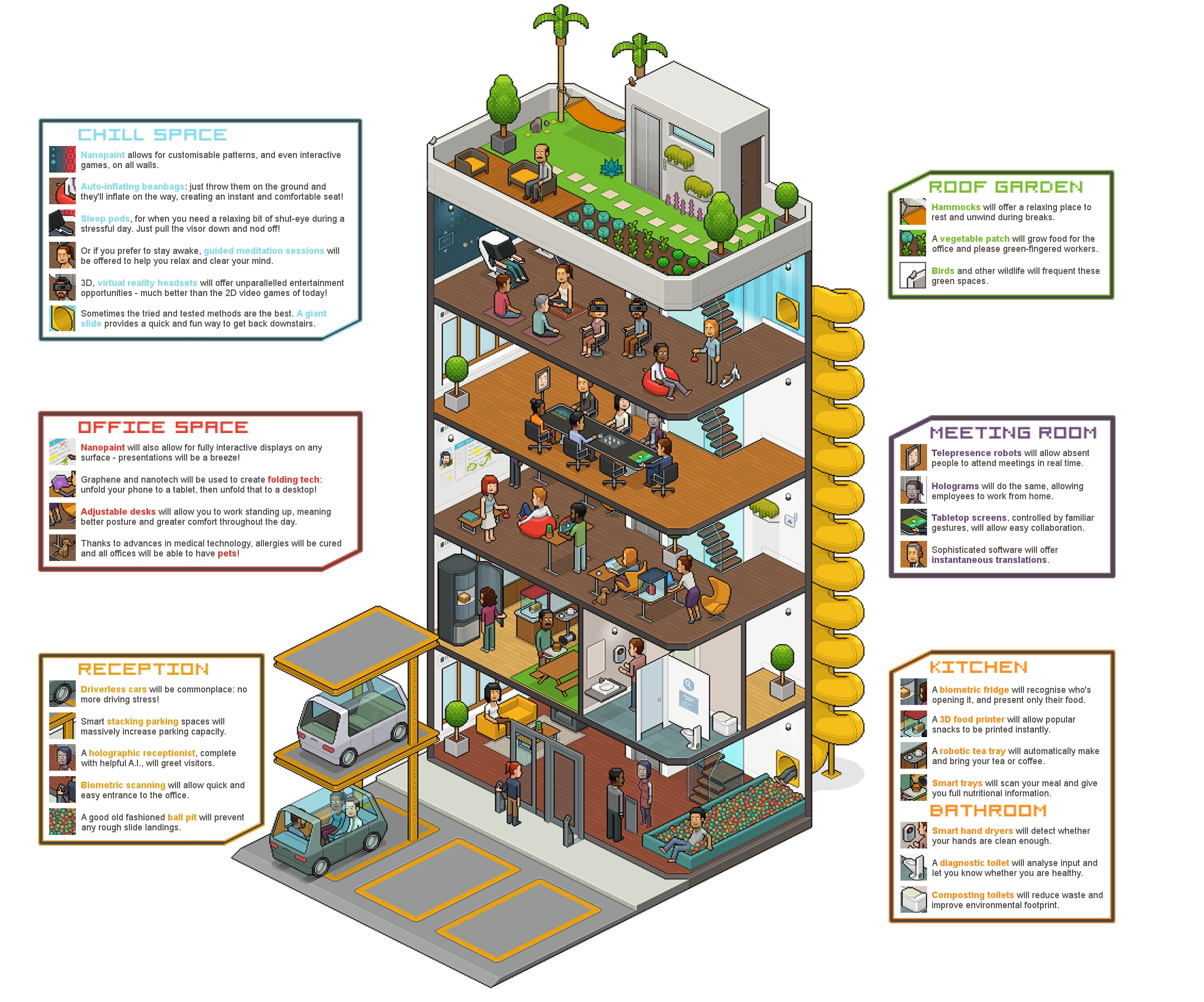Plusnet recently published a blog post titled “Office of the Future: Slides, Robots and Hammocks: Room by Room Breakdown,” in which they predict what offices will look like 15 years from now.
Technology has been a key player in the workplace revolution, and from the looks of Pulsnet’s prediction we can assume that its role will continue to drive some of the major changes that we will see in the future.
The image below details how each room, or part of the workspace, will change or evolve by 2030. As you’ll be able to see for yourself, most of these innovations will be possible thanks to new technologies that are in the process of being developed or that will be developed in the near future.
What we’re seeing here is the continued shift towards achieving work-life balance, which is observable in the attention that’s given to wellness and health factors. There’s also a stronger pull towards automation and artificial intelligence, which doesn’t come as a surprise given recent AI developments and improvements.
In terms of design, Pulsnet is strongly leaning towards open-plan spaces, however we don’t agree with them. As we’ve mentioned previously, the flexible workspace industry is starting to implement hybrid models as the market demands more flexibility in terms of the space they require for different situations.
An important element to draw attention to is how workplaces of 2030 will be more environmentally friendly. Though there already exist workspaces that implement eco-friendly practices today, these will only increase in number as younger generations are more environmentally conscious and as governments are likely to set legislations that require businesses to adhere to certain environmental standards.
Continue to the next page for more details on the main features of workplaces of the future.
The main features, according to the full report published by Pulsnet include:
- Driverless cars
- Automated car stacking car park
- Biometric register – thumb-print scanners on all entrances to replace paper-based registers
- Artificial intelligence assistants – hologram receptionists to meet and greet visitors
- Fully ergonomic chairs – using biofeedback technology they will know which position will be most comfortable and will automatically adjust
- Foldable computers – there is speculation that graphene will lead to super thin computers
- Full cloud integration – everything will operate through the cloud
- Fully customisable desks
- 3D printers – allowing workers to print pens and replacement PC parts
- Hologram projections in meeting rooms
- Universal translators during meetings
- Universal monitors – a table surface in meeting rooms will be electronic
- 3D food printers
- Health tracking trays
- Biometric rotating fridge – on touching the handle, the fridge detects who you are and a carousel rotates to show you only your food
- Drone tea trays – you program the robotic tray and it goes to the kitchen, makes your drinks, and brings them back
- Composting toilets – reducing water demand
- Diagnostic toilets that analyse your health
- Smart hand dryers – detecting cleanliness
- Changeable walls – wall surface that can change colour
- Slides – based on Google’s penchant for slides in offices, this will be more widespread in the future as the morale benefits are noticed
- Auto-inflate bean bags – personal pocket-sized beanbags that inflate when they’re thrown towards the ground
- Nap space
- Virtual reality gaming machines – headsets where employees can plug in and zone out
- Wellbeing room – meditation, chiropractors and counsellors available
- Wireless power: no need for plugs.
- Energy saving daylight bulbs
- Climate control: simulates outside weather, complete with slight breeze, when ambient temperature.
- Roof garden
- Nanopaints allowing the walls to be used as screens on demand
In order to make the right predictions, Pulsnet interviewed various futurists and visionaries on how they envisioned the office of the future and the technologies that would be necessary for these changes, as well as the technologies that they believed would be the next ‘big thing’.
You can read Pulsnet’s article here and you can access the full Office of the Future report here.


 Dr. Gleb Tsipursky – The Office Whisperer
Dr. Gleb Tsipursky – The Office Whisperer Nirit Cohen – WorkFutures
Nirit Cohen – WorkFutures Angela Howard – Culture Expert
Angela Howard – Culture Expert Drew Jones – Design & Innovation
Drew Jones – Design & Innovation Jonathan Price – CRE & Flex Expert
Jonathan Price – CRE & Flex Expert












